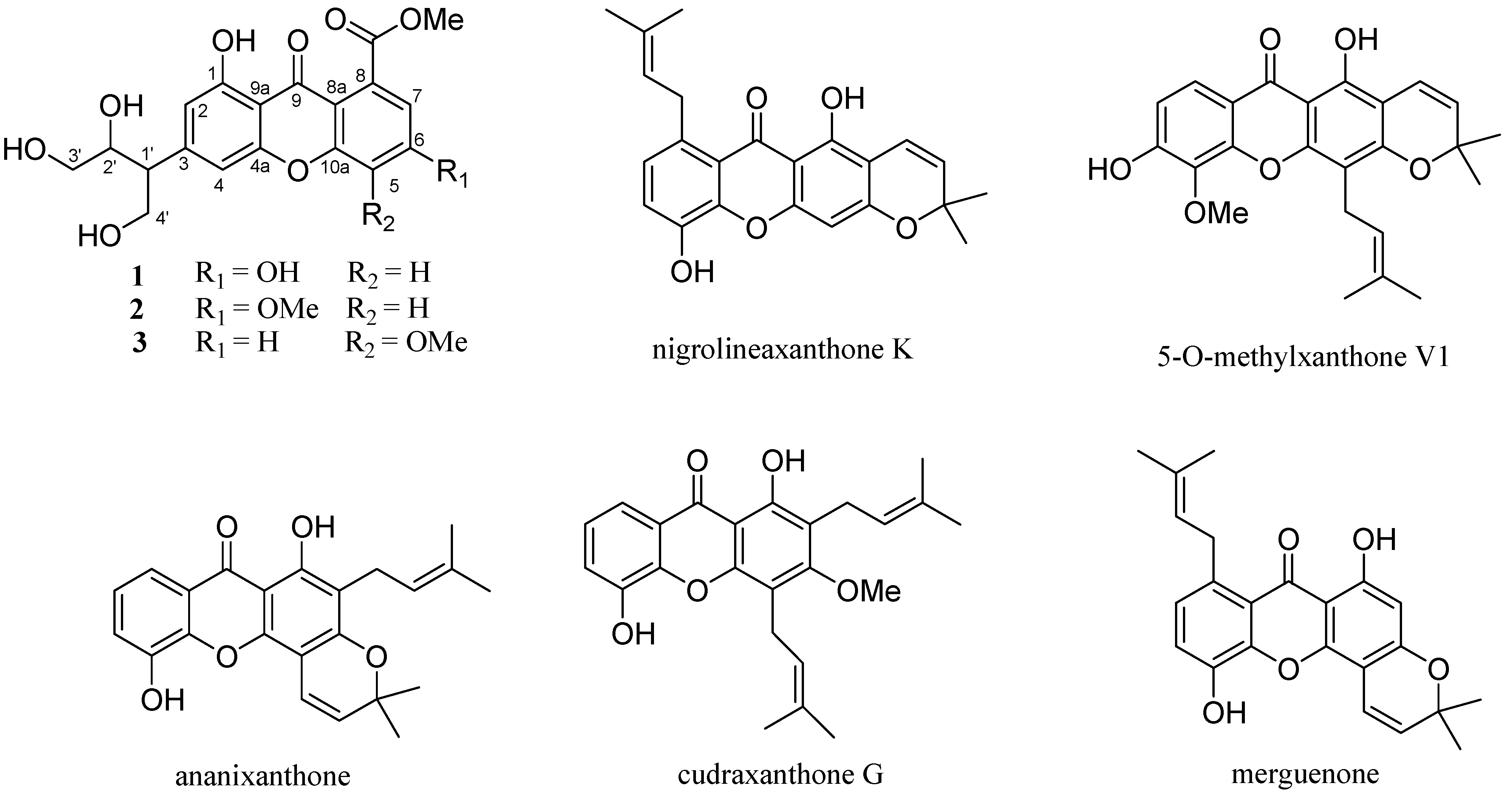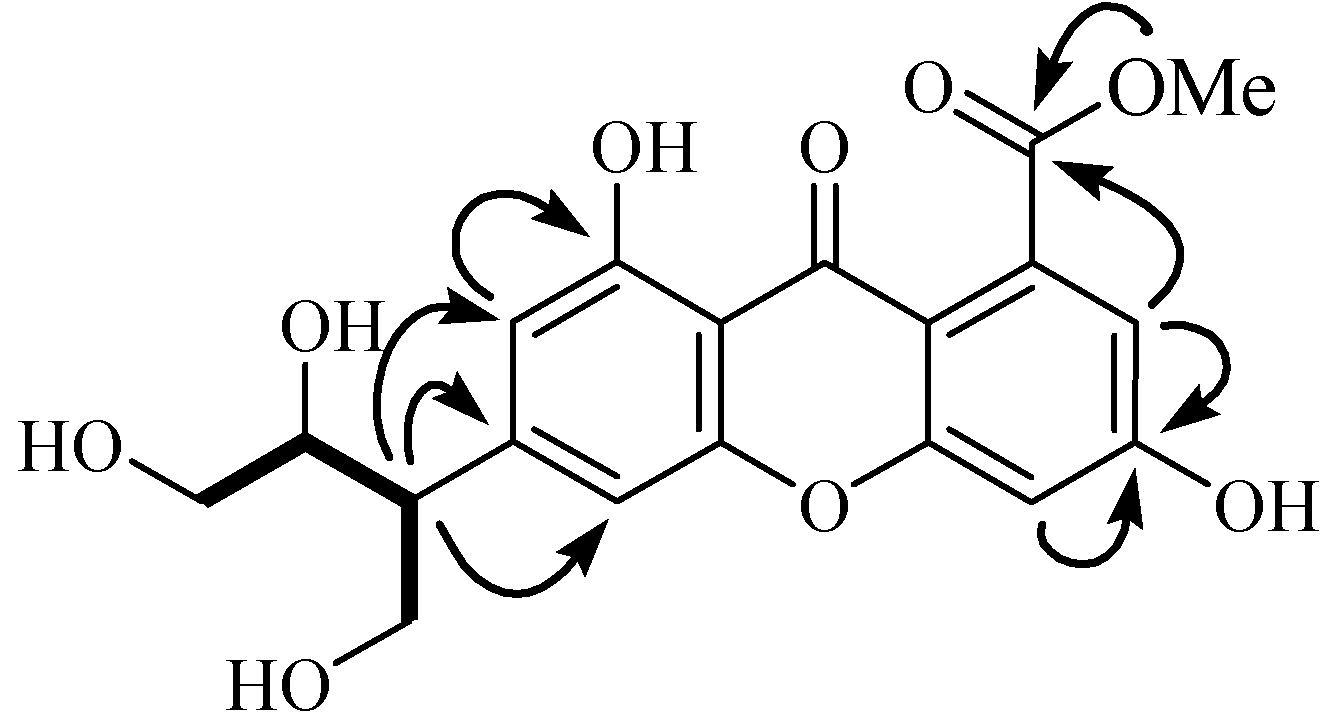Three Novel Xanthones from Garcinia paucinervis and Their Anti-TMV Activity
Abstract
:1. Introduction

2. Results and Discussion
| No. | 1 | 2 | 3 | |||
|---|---|---|---|---|---|---|
| δC (m) | δH (m, J, Hz) | δC (m) | δH (m, J, Hz) | δC (m) | δH (m, J, Hz) | |
| 1 | 162.7 s | 161.8 s | 161.4 s | |||
| 2 | 108.5 d | 6.75 s | 108.8 d | 6.75 s | 110.0 d | 6.94 d (1.8) |
| 3 | 149.1 s | 149.0 s | 145.2 s | |||
| 4 | 104.1 d | 7.00 s | 104.8 d | 7.00 s | 108.8 d | 7.07 d (1.8) |
| 5 | 103.0 d | 6.89 s | 102.3 d | 6.93 s | 156.0 s | |
| 6 | 165.1 s | 167.1 s | 121.5 d | 7.70 d (8.8) | ||
| 7 | 113.8 d | 6.80 s | 112.7 d | 6.84 s | 125.2 d | 7.39 d (8.8) |
| 8 | 136.8 s | 137.1 s | 126.5 s | |||
| 9 | 181.9 s | 181.8 s | 181.5 s | |||
| 4a | 155.6 s | 155.0 s | 157.0 s | |||
| 8a | 109.2 s | 109.7 s | 119.4 s | |||
| 9a | 107.4 s | 107.7 s | 107.8 s | |||
| 10a | 158.4 s | 157.2 s | 146.8 s | |||
| 1′ | 42.1 d | 4.41 m | 43.0 d | 4.44 m | 41.8 d | 4.42 m |
| 2′ | 72.3 d | 5.14 m | 72.0 d | 5.29 m | 72.0 d | 5.13 m |
| 3′ | 66.0 t | 4.63 m | 66.0 t | 4.74 m | 66.2 t | 4.64, 4.71 m |
| 4′ | 61.8 t | 4.13, 4.19 m | 62.0 t | 4.20 m | 61.8 t | 4.17, 4.22 m |
| 5′ | 169.4 s | 169.7 s | 169.0 s | |||
| 5-OMe | 55.9 q | 3.79 s | ||||
| 6-OMe | 56.2 q | 3.80 s | ||||
| 5′-OMe | 52.4 q | 4.04 s | 52.5 q | 4.11 s | 52.5 q | 4.02 s |
| Ar-OH-1 | 13.07 s | 13.79 s | 13.22 s | |||
| Ar-OH-6 | 12.83 s | |||||

| No. | % Inhibition at 20 µM | IC50 (µM) |
|---|---|---|
| 1 | 43.2 ± 2.3 | 21.4 ± 2.3 |
| 2 | 28.7 ± 3.0 | 42.8 ± 3.0 |
| 3 | 24.8 ± 2.2 | 53.6 ± 2.2 |
| 4 | 9.22 ± 2.8 | ≥200 |
| 5 | 18.9 ± 2.6 | 82.4 ± 2.6 |
| 6 | 17.8 ± 2.3 | 68.9 ± 2.3 |
| 7 | 16.1 ± 3.0 | 52.8 ± 3.0 |
| 8 | 13.1 ± 3.0 | ≥200 |
| Ningnamycin | 30.5 ± 2.4 | 36.9 ± 2.4 |
3. Experimental
3.1. General
3.2. Plant Material
3.3. Extraction and Isolation
3.4. Anti-TMV Assays
4. Conclusions
Supplementary Materials
Acknowledgments
Conflicts of Interest
References
- Sakagami, Y.; Iinuma, M.; Piyasena, K.G.; Dharmaratne, H.R. Antibacterial activity of α-mangostin against vancomycin resistant Enterococci (VRE) and synergism with antibiotics. Phytomedicine 2005, 12, 203–208. [Google Scholar] [CrossRef]
- Gopalakrishnan, G.; Banumathi, B.; Suresh, G. Evaluation of the antifungal activity of natural xanthones from Garcinia mangostana and their synthetic derivatives. J. Nat. Prod. 1997, 60, 519–524. [Google Scholar] [CrossRef]
- Nakatani, K.; Yamakuchi, T.; Kondo, N.; Arakawa, T.; Oosawa, K.; Shimura, S.; Inoue, H.; Ohizumi, Y. γ-Mangostin inhibits inhibitor-kB kinase activity and decreases lipopolysaccharide-induced cyclooxygenase-2 gene expression in C6 rat glioma cells. Mol. Pharmacol. 2004, 66, 667–674. [Google Scholar] [CrossRef]
- Jung, H.A.; Su, B.N.; Keller, W.J.; Kinghorn, A.D. Antioxidant xanthones from the pericarp of Garcinia mangostana (Mangosteen). J. Agric. Food Chem. 2006, 54, 2077–2082. [Google Scholar] [CrossRef]
- Gao, X.M.; Yu, T.; Lai, F.; Zhou, Y.; Liu, X.; Qiao, C.F.; Song, J.Z.; Chen, S.L.; Luo, K.Q.; Xu, H.X. Identification and evaluation of apoptotic compounds from Garcinia paucinervis. Bioorg. Med. Chem. 2010, 18, 4957–4964. [Google Scholar] [CrossRef]
- Gao, X.M.; Yu, T.; Lai, F.; Qiao, C.F.; Zhou, Y.; Liu, X.; Song, J.Z.; Luo, K.Q.; Xu, H.X. Novel polyisoprenylated benzophenone derivatives from Garcinia paucinervis. Tetrahedron Lett. 2010, 51, 2442–2446. [Google Scholar]
- Han, Q.B.; Wang, Y.L.; Yang, L.; Tso, T.F.; Qiao, C.F.; Song, J.Z.; Xu, L.J.; Chen, S.L.; Yang, D.J.; Xu, H.X. Cytotoxic polyprenylated xanthones from the resin of Garcinia hanburyi. Chem. Pharm. Bull. 2006, 54, 265–267. [Google Scholar] [CrossRef]
- Li, X.W.; Li, J.; Stevens, P.F. Flora of China; Science Press: Beijing, China, 2007; Volume 13. [Google Scholar]
- Rukachaisirikul, V.; Kamkaew, M.; Sukavisit, D.; Phongpaichit, S.; Sawangchote, P.; Taylor, W.C. Antibacterial xanthones from the leaves of Garcinia nigrolineata. J. Nat. Prod. 2003, 66, 1531–1535. [Google Scholar] [CrossRef]
- Hoison, O.; Cuong, D.D.; Gramain, A.; Anthony, C.; Angele, H.; Nguyen, V.; Sevenet, T. Further rearranged prenylxanthones and benzophenones from Garcinia bracteata. Tetrahedron 2005, 61, 8529–8535. [Google Scholar] [CrossRef]
- Bayma, J.C.; Arruda, M.S.P.; Neto, M.S. A prenylated xanthone from the bark of Symphonia globulifera. Phytochemistry 1998, 49, 1159–1160. [Google Scholar] [CrossRef]
- Hano, Y.; Matsumoto, Y.; Sun, J.; Nomura, T. Constituents of the Moraceae plants. Part 1. Components of root bark of Cudrania tricuspidata. Part 4. Structures of three new isoprenylated xanthones, cudraxanthones E, F, and G. Planta Med. 1990, 56, 399–402. [Google Scholar] [CrossRef]
- Nguyen, L.D.; Vo, H.T.; Pham, H.D.; Connolly, J.D.; Harrison, L.J. Xanthones from the bark of Garcinia merguensis. Phytochemistry 2003, 63, 467–470. [Google Scholar] [CrossRef]
- Yan, X.H.; Chen, J.; Di, Y.T.; Fang, X.; Dong, J.H.; Sang, P.; Wang, Y.H.; He, H.P.; Zhang, Z.K.; Hao, X.J. Anti-Tobacco Mosaic Virus (TMV) quassinoids from Brucea javanica (L.) Merr. J. Agric. Food Chem. 2010, 58, 1572–1577. [Google Scholar] [CrossRef]
- Song, B.A.; Zhang, H.P.; Wang, H.; Yang, S.; Jin, L.H.; Hu, D.Y.; Pang, L.L.; Xue, W. Synthesis and antiviral activity of novel chiral cyanoacrylate derivatives. J. Agric. Food Chem. 2005, 53, 7886–7891. [Google Scholar]
- Sample Availability: Samples of the compounds 1–3 are available from the authors.
© 2013 by the authors; licensee MDPI, Basel, Switzerland. This article is an open access article distributed under the terms and conditions of the Creative Commons Attribution license (http://creativecommons.org/licenses/by/3.0/).
Share and Cite
Wu, Y.-P.; Zhao, W.; Xia, Z.-Y.; Kong, G.-H.; Lu, X.-P.; Hu, Q.-F.; Gao, X.-M. Three Novel Xanthones from Garcinia paucinervis and Their Anti-TMV Activity. Molecules 2013, 18, 9663-9669. https://doi.org/10.3390/molecules18089663
Wu Y-P, Zhao W, Xia Z-Y, Kong G-H, Lu X-P, Hu Q-F, Gao X-M. Three Novel Xanthones from Garcinia paucinervis and Their Anti-TMV Activity. Molecules. 2013; 18(8):9663-9669. https://doi.org/10.3390/molecules18089663
Chicago/Turabian StyleWu, Yu-Ping, Wei Zhao, Zhen-Yuan Xia, Guang-Hui Kong, Xiu-Ping Lu, Qiu-Fen Hu, and Xue-Mei Gao. 2013. "Three Novel Xanthones from Garcinia paucinervis and Their Anti-TMV Activity" Molecules 18, no. 8: 9663-9669. https://doi.org/10.3390/molecules18089663




